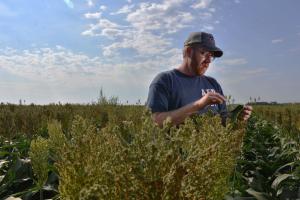Despite insect pressure on his central Kansas farm, sorghum farmer Adam Baldwin said his 2015 crop is on track to be his best yet.
“About a month ago, we scouted and came across sugarcane aphids in some of our fields,� Baldwin said.
Because of a research project conducted by Kansas State University (K-State), the aphids were detected early.
K-State monitored sugarcane aphid traps with infrared sensors in Baldwin’s fields, which allowed the researchers to track aphid levels and then suggest treatment methods.
“These recommendations aligned with what our crop scouts recommended as well,� Baldwin said.
Luckily, the tracking reported low infestation rates, and Baldwin only needed to spray a few fields with insecticide to kill the aphids. Additionally, Baldwin sprayed all his fields for sorghum headworms when they were detected. Unfortunately, the same treatment does not work for both insects.
Baldwin said he needs another good rain to finish off the sorghum crop and may wait until the first frost in his area to begin harvest. Ideally, sorghum harvest will begin in mid-October for Baldwin’s crop.
Some sorghum farmers Baldwin knows have already begun harvesting, and the reports are good, he said. According to a Sept. 21 USDA National Agricultural Statistics Service (NASS) report, 66 percent of the sorghum crop is listed in good to excellent condition, up 9 percent from last year’s report at the same time.
The recent devaluation of the Chinese currency has also had a small effect on the sorghum market.
“This change has allowed cattle feeders and ethanol plants back into the marketplace,� Baldwin said. “Importers who got priced out of the market now have an opportunity to get back in.�
Baldwin currently serves as vice president of the United Sorghum Checkoff Board and USGC Asia Advisory Team leader and recently visited China.
“From our trip, we received an impression about China’s import level in the coming months and where it might stabilize,� Baldwin said. “As a farmer, I explained to the importers that most growers’ decisions are made by Nov. 1 of the previous year and that the corn/sorghum relationship could change next year unless the buyers let it be known they want more sorghum and are willing to pay for it.�


